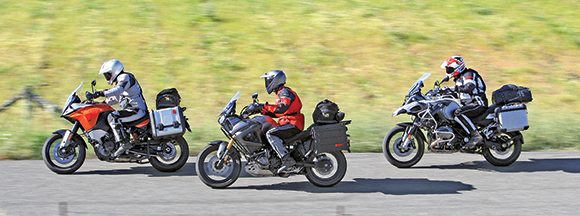
Although they represent a small minority of motorcycle sales, large-displacement adventure tourers have surged in popularity recently. Buyers are drawn to their one-bike-does-it-all versatility, combining high-performance engines and components, long-distance comfort and amenities, and on-/off-road capability. Given the uptick, manufacturers have invested heavily in new and updated models, some of which are the first (and only) bikes in an OEM’s lineup offered with technologies such as engine modes, multi-level ABS and traction control, and electronically adjustable/adaptive suspension systems.
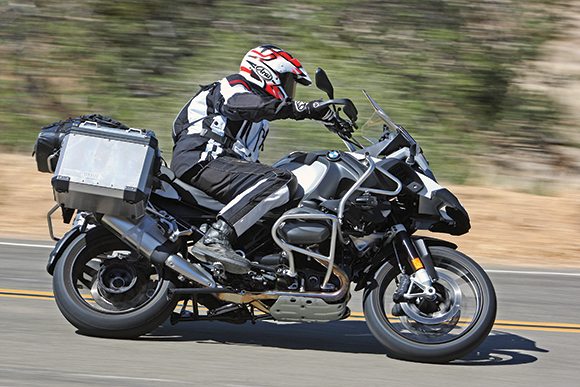
The BMW R 1200 GS Adventure, KTM 1190 Adventure and Yamaha Super Ténéré ES are the latest and greatest in the big-bore ADV segment. All three are new or updated for 2014, and they’re powered by 1,200cc twins and equipped with state-of-the-art technology. The new-for-2014 Suzuki V-Strom 1000 ABS is worthy of consideration (though in a smaller displacement category), but Suzuki was unable to make one available for this comparison. In evaluating these bikes, we focused on all-around, real-world ability rather than specific strengths. We requested them with factory accessory saddlebags, loaded them up with camping gear, and hit the road for several days of on- and off-road riding. Continue reading to see how they compare to each other; refer to the sidebars, specs and dyno charts for details on each model.
Although just 29cc separates the range of displacements for these three twins, differences in engine configuration, tuning and electronics make each one unique. With its superbike-derived, liquid-cooled, 1,195cc V-twin, the KTM is the king of horsepower, sending 131 ponies to the rear wheel on Jett Tuning’s dyno. The BMW’s air/liquid-cooled, 1,170cc flat opposed twin is next with 115.6 horsepower, but it out-torques the KTM with 82.4 lb-ft vs. 80.4. Despite having the largest displacement, the Yamaha’s liquid-cooled, 1,199cc parallel twin makes the least output, with 97.4 horsepower and 75.9 lb-ft of torque.
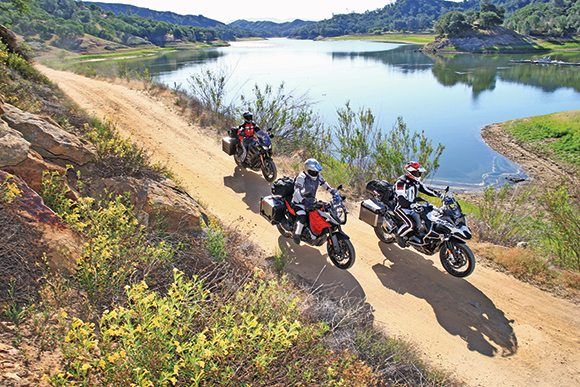
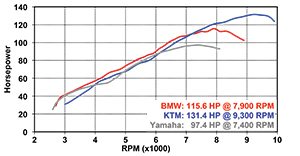
Peak figures don’t tell the whole story, and they say nothing about engine character and throttle response. The KTM’s horsepower and torque advantages over the BMW only emerge above 7,100 rpm, becoming very large above 8,200 rpm; the BMW signs off at 9,000 rpm while the KTM redlines at 10,000, the Yamaha at 8,000. Between 3,000 and 7,000 rpm—the heart of the rev range where riders spend most of their time—the BMW exhibits its largest horsepower and torque advantage over the KTM and Yamaha.
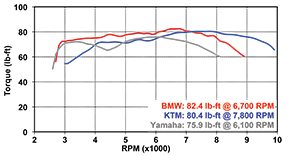
The rev-happy KTM is the most sportbike-like in its engine performance and character, which is accentuated by the fact that it’s the lightest bike here by at least 70 pounds (552 pounds wet vs. 623 for the BMW and 639 for the Yamaha). The KTM is exciting but somewhat high-strung, and it’s the only bike here that radiated excessive engine heat. Thanks to its heavy crank and low-end torque, the BMW is the most tractable at low speeds and drew praise for its overall performance. Though down on power and torque, the Yamaha held its own. The bikes’ 6-speed transmissions and hydraulically actuated wet clutches change gears with ease, and for long stretches of open road, the BMW and Yamaha have cruise control but the KTM does not.
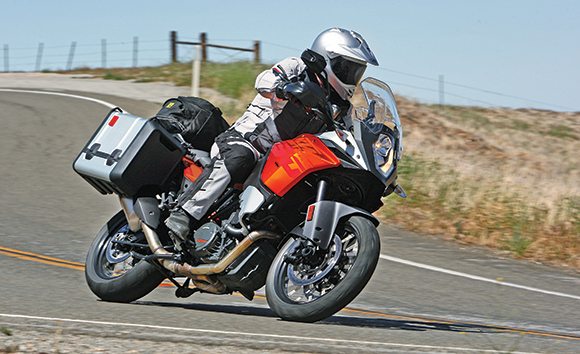
All three bikes have riding modes that are easy to change on the fly and vary in terms of systems integration. The BMW’s five modes (Dynamic, Road, Rain, Enduro and Enduro Pro) alter throttle response, ABS, traction control and electronic suspension. The KTM’s four modes (Sport, Street, Rain and Off-road) alter throttle response, engine output (Rain and Off-road cut horsepower to 90 and torque to 65 lb-ft) and traction control, but ABS and electronic suspension are controlled separately. The Yamaha’s D-Mode system offers two throttle response options only (Sport and Touring); ABS is always on, and traction control and electronic suspension are controlled independently. The BMW does the best job of streamlining the complexity of today’s electronics-laden motorcycles—just pick a mode, and everything else is taken care of. On the KTM, selecting Off-road mode adjusts engine/throttle response and traction control, but you must remember to separately change ABS from Road to Off-road (or off), and suspension changes require a third step. Likewise, the Yamaha requires separate steps to adjust D-Mode, traction control and suspension. Our biggest complaint about the Yamaha is that Touring mode feels lethargic and Sport mode is sensitive to small throttle inputs.
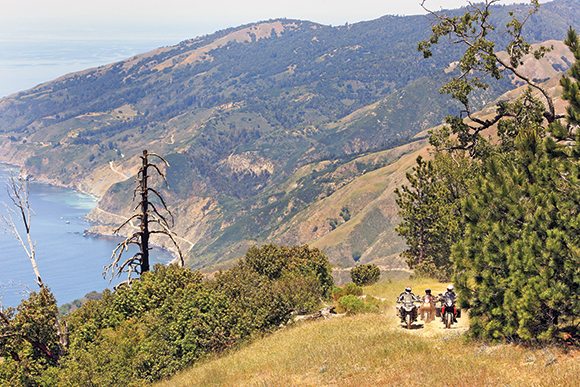
The BMW’s extra-tall suspension and 7.9-gallon tank make it look and feel massive relative to the KTM and Yamaha, but with the shortest wheelbase and sharpest steering geometry, it’s surprisingly nimble. With its Telelever front suspension and semi-active Dynamic ESA—the only bike here with suspension that automatically adjusts damping to conditions in real-time—the BMW is the most stable, with virtually no chassis pitch during braking and acceleration. Regardless of ESA setting (Soft, Normal or Hard), the BMW is plush and well controlled. Although it has the longest wheelbase, more relaxed geometry and relatively narrow handlebars, the KTM feels as agile as the BMW by virtue of its lighter weight. Its Electronic Damping System (EDS) offers adjustable preload and damping (Sport, Street, Comfort) settings, and overall damping is the firmest of the three. With the most conservative steering geometry and heaviest weight, the Yamaha steers heavier than its European counterparts. Its electronic suspension system adjusts preload and damping, and provides a comfortable, compliant ride.
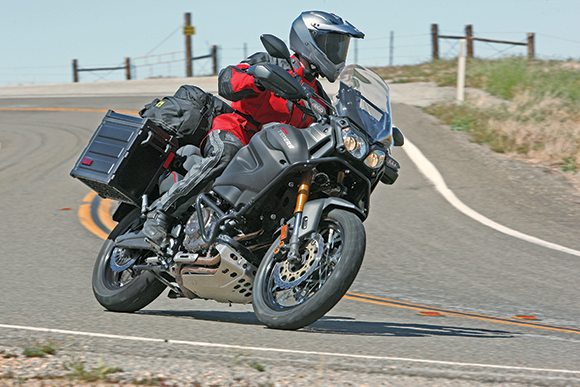
Our 700-mile test included about 50 miles of mixed off-road riding, from loose gravel and sand to rutted hard pack. All three bikes run spoked wheels with 90/10 on-/off-road tubeless tires, and they feel sure-footed on the trail despite their size and weight (reducing tire pressure helps, but the BMW’s and KTM’s tire-pressure monitors will flash warnings). Given KTM’s dirt bike heritage and significantly lower mass, it’s the preferred mount for negotiating technical conditions. The BMW’s low-end torque and unflappable Dynamic ESA make it extremely forgiving, soaking up the rough stuff better than the others. The Yamaha comports itself well off-pavement, but vague throttle response makes it difficult to be smooth at low speeds.
Triple-disc brakes linked front-to-rear and standard ABS are common to all three bikes. The BMW and KTM have dual Brembo radial-mount, 4-piston front calipers and a single Brembo 2-piston rear caliper, and both offer excellent braking power and modulation. The Yamaha’s dual Advics 4-piston front calipers and single Akebono 1-piston rear caliper offer plenty of power but less precise feel at the lever. ABS is available with on- and off-road modes on the BMW and KTM, or it can be turned off. The KTM is unique in offering Motorcycle Stability Control, an anti-lock braking system that works when leaned over in a corner, a very valuable safety feature. The Yamaha has a single ABS mode and it cannot be disengaged, but we were surprised by how well the brakes on all three bikes worked off-road at the prudent, Jeep-like pace we maintained, even on steep downhills.
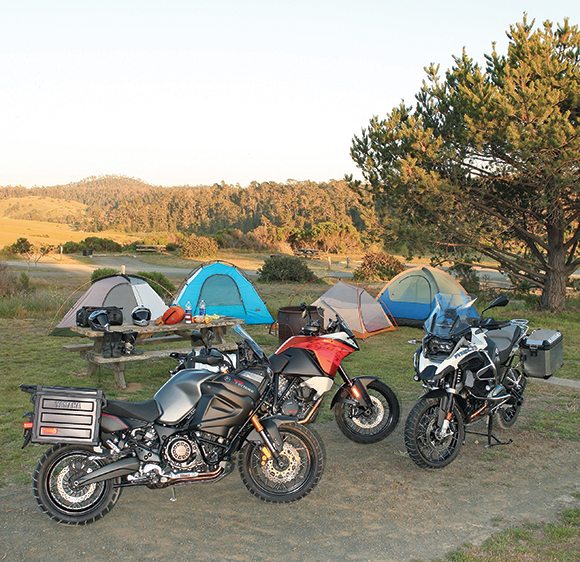
With the largest windscreen, the softest seat and the plushest suspension, the BMW is the most comfortable of the three, hands down. The KTM and Yamaha have firm seats that provide good support but take their toll as the miles pile up, especially on the KTM. Their windscreens are similar sizes and shapes, offering decent coverage but more noise and buffeting than on the BMW. All three offer upright seating positions with wide handlebars and dual-height seats. The BMW’s seat heights are the tallest of the three (35.0/35.8 inches; an optional low seat is 33.1/33.9 inches), followed by the KTM (33.8/34.4 inches) and Yamaha (33.3/34.3 inches). The height and weight of the BMW, especially with fully loaded saddlebags and a tailbag, presents a serious challenge to shorter riders when mounting up and lifting it off its sidestand, with the KTM only slightly better.
Part of the appeal of big adventure tourers is the ability to load them up and hit the road for days, as we did, so load capacity can be an issue. With factory accessory saddlebags mounted on each bike, BMW offers the highest load capacity at 433 pounds, followed by 419 for the KTM and 397 for the Yamaha. The BMW’s durable, Touratech-made aluminum saddlebags hold the most (80 liters) and are the easiest to use. The KTM’s 73-liter, side-loading saddlebags require more finesse, while the Yamaha’s 61-liter top-loaders have balky latches. Fuel economy figures were similar, with the BMW and Yamaha averaging 40 mpg and the KTM averaging 37 mpg. With its 7.9-gallon tank, the BMW’s range is 313 miles; the KTM and Yamaha both carry 6.1 gallons of fuel, for 227 miles and 244 miles of range, respectively.
After three long days of adventure touring, we came to appreciate each of these bikes for different reasons. When the four of us—three test riders and a photographer, covering a range of ages, sizes and experience—were asked which bike we’d choose if we could have only one, three picked the BMW and one picked the KTM, primarily because the BMW is so big and cumbersome.
We agreed that the BMW R 1200 GS Adventure is the all-around most comfortable, capable and enjoyable motorcycle here. There’s nothing it didn’t do well. Its extra-long suspension and Dynamic ESA deliver the plushest ride, its torquey engine is the most versatile, it handles well, and its features are comprehensive and well engineered. On the other hand, it’s a large, heavy machine with the tallest seat height, putting it out of reach for many. And the BMW’s as-tested price of $22,835 exceeds that of the other two by $4,800-$5,000.
The KTM is appealing for its sportbike-like performance on pavement and its dirt bike-like performance off-road. It’s much lighter than the other two, but a big part of that is chain final drive, which requires regular maintenance. It radiates the most engine heat and has the hardest seat and firmest suspension damping, limiting its long-haul appeal. On the other hand, it’s packed with standard features and is more reasonably priced ($17,834) than the BMW.
For those who don’t need the luxury of the BMW or the performance of the KTM, the Yamaha Super Ténéré ES remains a solid choice. It could stand to lose a few pounds and gain a few horsepower, but while riding it such issues rarely come to mind. Though more basic in some respects, the Yamaha ($18,043) offers the lowest seat height and the sort of reliability and reasonable costs of ownership that Japanese motorcycles are known for.
In the end, none of these bikes are losers. They carried us comfortably and capably over many miles through a range of conditions. Each has particular strengths—performance, features, price, etc.—that will appeal to different people. If you’re in the market for a new big-bore adventure tourer, you can’t go wrong.
CONTINUE READING
You can find more details about each bike here:
* 2014 BMW R 1200 GS Adventure
* 2014 KTM 1190 Adventure
* 2014 Yamaha Super Ténéré ES


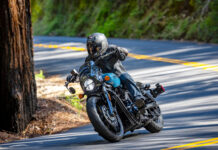






This “shootout” sounds like the writer didn’t want to piss off any of their advertisers.
Not that great of a story.
Typical BMW fanboi stuff from you idiots.
You guys ride for an hour and get pictures.
Go to IHOP and look at the sales stuff from BMW while eating too much.
Write a bunch of drivel that doesn’t do justice to ANY of the bikes – not even the BMW (which you guys obviously leg hump big time)
Go home and look at metric cruisers and remember the good ol’ days when pirate clothes were cheaper…
How about…revising the last paragraph…
When you have a Beemer…why would one want to spend time at the IHOP.
Clearly you haven’t been there….cause there are no Beemers there.
I would rather be riding one of those wonderful machines …. than hanging around a diner…or bar.
Cheers
Hi guys. I thought I’d put a pennies worth in after reading the other comments. I live in Australia and my friends and I have done a lot of miles on these machines. Your write up is okay, as the rider makes all the difference to these bikes capabilities. Each bike is only as good as its pilot in the end and most of my buddies love the BM too. And these guys can ride as their trophy cabinets will attest. We ride deserts, dirt roads and even single track, as long as the cylinders can get through. Their all great bikes but the BM does Have an edge. Thanks, Hugo.
Save all that $$$$$$ and Buy a KLR 650… With what you saved you can TRAVEL the world… How can 52 MPG be a bad thing?
That’s what I don’t understand? BMW rates constantly near the bottom in issues while Yamaha is number 1 in quality. Why isn’t that the focal point in comparisons? I’ve got 4 YAMAHA’s in my garage, 2008~2014 and zero issues! Partial to Yamaha, hell yeah! I’d rather be riding than waiting on my bike to come out of the shop. I want to spend my money on farkles and vacation expenses without paying for bike repairs. Said my peace!
I wonder if KLR owners go to Mercedes Dealerships and tell customers, “Save all that $$$$$ and get a Kia…” You aren’t gonna win any converts. People considering these bikes have the means to get them. If they wanted a bargain basement bike, they’d be reading DR 650/ Honda XR 650L comparisons. KLR’s are completely irrelevant to this article. BMW offers the G650 GS in the KLR’s class. And it gets 73 MPG with Fuel Injection, ABS, and a 3 yr Warranty to go along with its higher resale value. But I digress. In this Big Trailie class, the BMW is the clear winner. If you don’t like this class of bike, save your opinion for a more appropriate comparo.
I have this GS1200 adventure. Nothing but trouble:
-Fuell gauge broken. BMW tell if replaced no warranty because it just is no good
-2x gas sensor (pot meter) broken, no fuel in the cylinder and calling for being picked up
-abs broken (again) well known issue
– seat hurts after one hour. replaced by a USA corbin. thats ideal!
– almost impossible to start the bike when battery is not 100% full
-bike is really heavy when standing still, after 10 degrees angle it will fall
-all parts bad quality alu coating falls of after few years on tank and other body work
-repairs for abs and fuel sensor Euro 2000,- !! are they crazy!
back to honda, never ant to the garage
another gushing GS 1200 article. I just spent 2 days and 600 miles across Arizona on a 2014 GS. I dont understand the fuss. What the reviewer fails to mention – after 2 hours your butt is so sore you need to get off. There is no room to move forward and back. But worst of all there is no steering feel at all thanks to the bizarre and over engineered telemetric suspension. It floats like an old Buick. And the ride lets you down all the time – too hard when you want soft, too soft when you want firm. Sorry but give me a KTM or a Multi or the Yamaha for that matter. If you have your deposit on a GS1200 and are waiting for a few months ride the KTM, the Multi, even the Triumph.
The Multi-Strada would be my choice….then the GS (but not the Adventure…it is too heavy).
But as far as comfort….many of my friends ride the GS. Not one complains of discomfort. These guys…like yours truly…regularly do 500+ mile days.
But then again….all derrieres are not made equal. You may have one that is better suited for some other bike seat.
I own a S10, my friends own a BMW.
They swear by theirs and I swear by mine.
We all ride the Karakoram Highway every year.
We all fall down at some point on a tricky dirt track. We all come home happy, smiling and lots of memories to cherish.
However, when i look at my S10, I see a bike with money spent on the aftermarket stuff. Had I gone for the BMW, the aftermarket would have had to wait.
Suspension, I am more tuned to conventional forks, I don’t like the idea of no feel form the front end as it navigates on rough gravel, because it doesn’t tell me when to adjust my body to keep my bike upright.
Seat, every stock bike is going to end up giving the rider sore butt, in a couple of hours max. My remedy is air hawk 2 DS. I got 10-12 hrs riding, for 8 days to prove that it works for me. But you need to get used to the feeling of air moving on your seat.
Engine, its not the fasted, but having a fast bike doesn’t matter on the long haul. If you haven’t prepped your bike properly to suit your needs, the wind buffeting will ruin your day at high speeds.
I do save much more than my beemer friends due to low maintenance cost. Some of my friends have this irritating look because they pay more for the same stuff.
And i love the fact that the S10m is built tough. It gives the assurance that I could take it in wilderness and not worry about having left my SPOT at home. My beemer friends usually have a recovery vehicle following if they decide to go off the beaten path.
In the end, what I have concluded is, with the higher price tag comes greater expectations and hence alot of times the bike falls short. In the end, it doesn’t matter, I’ll ride the same road as my beemer friends, they have a smile maybe because they have a beemer, whereas I have a smile because I know I have more reliable, dependable tank of a bike.
I’ve ridden both the GS and Super Ten. Am a bit dirt orientated and I reckon the Yam is more dirt than the gs – and the gs is more tar than the Yam.
If you compare geometry and you know something about it – you can see the Yam is designed more dirt in its fork rake and trailing arm.
If you want adventure dirt roads with some tar – it the Yamaha.
If you want adventure tar roads with some dirt – its the GS.
Makes sense really when you look at which brand has had the best dirt bike history!